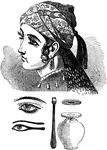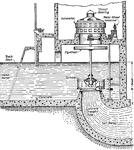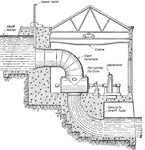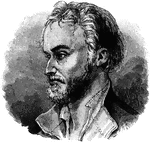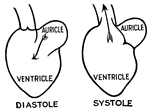
Heart Cycle
The cycle of the heart in its diastole (relaxation) state and its systole (contraction) state. The ventricles…
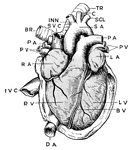
Anatomy of Heart
A complex anatomical view of the heart. RA is the right atrium, or auricle, which receives the deoxygenated…
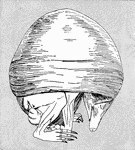
Skinned Hedgehog
A skinned hedgehog. This image is supposed to show the muscles of the back which contract to make the…

Steering Device
A Worm and sector steering device, cross-sectioned. It was developed by Panhard-Levassor. The spindle…

Peteler locust crushing machine
The Peteler locust crushing machine was a horse drawn device used to trap and kill locusts. Locusts…

KIng Suction Machine
The King Suction Machine was considered one of the most effective locust extermination machines of its…
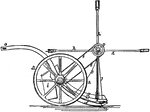
Wilson-Rhode Locust Catcher
The Wilson-Rhode locust catcher was a horse-drawn device used to trap and kill locusts. Locusts were…
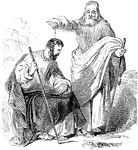
Anointing
Anointing with oil was a custom among the Hebrews and other oriental nations. Behold, how good and how…

Smooth-coated Fox-terrier
The Fox-terrier is not an old breed, only dating back about a century; but the fox-terrier's cleverness,…
Nerve Ganglia (Spinal)
Nerve Ganglia, or Knots (sing. Ganglion; Knot) occur as collections of nerve cells on the course of…
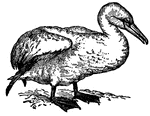
Gannet
Also known as a Solan Goose (Sula bassana), the Gannet is a large marine bird which nests in scattered…
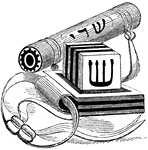
Frontlet
A frontlet that is tied to the head during weekday morning prayers. "That thou mightest fear The Lord…

Gauntlet
The Gauntlet is a piece of protective armor for the hand, dating back to the 12th century. The first…
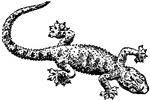
Gecko
A gecko is a small, four-footed member of the lizard family Geckonidae. Geckos are widely distributed…

Head of Gems'bok
This illustration shows a head of a Gems'bok. A Gems'bok (Oryx Gazella) is a species of South African…
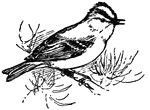
Golden-Crested Wren
Also known as the Kinglet, the Golden-Crested Wren (Regulus cristatus) is the smallest of European birds.…

British Golden-rod
British Golden-rod is a member of the large composite genus Solidago, which is chiefly North American.…
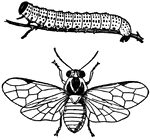
Gooseberry Caterpillar (Nematus ribesii) and Sawfly
Gooseberry Caterpillar is the name applied to the larvæ of two different insects, both injurious to…
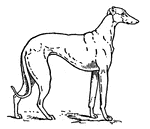
Greyhound
The Greyhound as a show dog is judged as follows: height and weight, ranging from 23 to 27 in. and from…
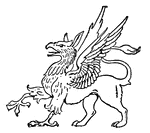
Griffin
In heraldry, the griffin is a fabulous animal, with the head and forefeet of an eagle, and the body,…
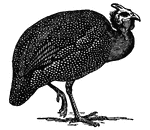
Guinea Fowl
Guinea Fowl are the African representatives of the pheasants, from which they differ in that the plumage…

Jumping Hare
The Jumping Hare, also known as the Springhaas, is a large African jerboa (Pedetes caffer). In size,…

Great Kangaroo
The Great Kangaroo, or 'boomer', or 'old man' (Macropus giganteus), attains a height of about five feet…

Blackwall Hitch
To tie a blackwall hitch, form a bight at the end of a rope, and put the hook of a tackle through the…
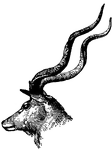
Head of Kudu
This illustration shows the head of a kudu. A kudu is a large African antelope related to the eland,…
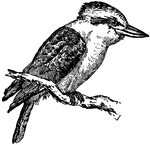
Kingfisher, Dacelo gigas
The Settler's Clock ('Dacelo gigs'), is a very large kingfisher found in Australia, where it receives…

Colored Leaves of 'Cornus florida'
This illustration shows the colored leaves of 'Cornus florida', surrounding the small flowers and rendering…

Cross of the Legion of Honor
The Cross of the Legion of Honor is a decoration composed of a star of five double rays, with a wreath…

Surveyor's Level
This illustration shows a Surveyor's, or Y-level. In use, the telescope is set perfectly horizontal…

Medal of Abila
A medal of Abila, representing the head of Faustina, wife of emperor Marcus Aurelius on one side. The…

Fortune
A female depiction of Fortune with many iconic symbols, such as the rudder, the cornucopia, and ears…

Medal of Bostra
A medal of Bostra, with the head of Trajanus Decius on one side and a female figure with her head wrapped…

Medal of Caesarea Libanus
A Medal of Caesarea Libanus. On one side the head of Alexander Severus is engraved. Depicted on the…

Medal of Dor
A medal showing Astarte on one side, who was worshiped in Dor as the principle of fertility. The other…

Jupiter
A medal engraved with the image of Zeus, or Jupiter, next to a sphinx; the other side of the coin depicts…

Marcus Aurelius Antoninus
A medal engraved with the head of Marcus Aurelius Antoninus, with his name in the inscription. On the…

Medal of Gaza
A medal of Gaza, representing the turreted head of a goddess, Astarte; on the other side of the medal…

Medal of Gaza
Another medal of Gaza. On one side it shows the head of Emperor Commodus, with his name inscribed. The…

Medal of Jerusalem
A medal of Jerusalem, depicting how the city was rebuilt by Hadrian after being destroyed by the Romans.…
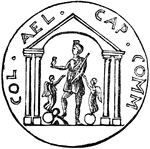
Astarte
Ashtaroth, or Astarte, was among the idols of Syria; this medal shows she was worshiped in Jerusalem.…
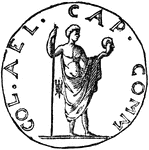
Coin of Hostilianus
A coin of Hostilianus, with a figure standing with a blunt spear in his right hand and a human head…

Vespasian
A medal with the portrait of Vespasian engraved on one side; the other side shows a figure representing…

Parthia
The head engraved on one side of the coin is thought to be the portraits of the king of Parthia. In…

Medal with Heads
A medal containing two circles of heads, each having seven, male and female alike. The heads of the…

Apollo
Apollo, the god of day, his head surrounded by rays. His chariot bears similarities to a rainbow. It…

Medal of Tyre
A medal of Tyre, depicting the Tyrians presenting a plan of their city to Dido, the Queen of Carthage.…

Machinery
General arrangement of machinery. A, upcast shaft; b, winding gear; c, downcast shaft; d, porch; e,…

Dobby Motion
Cotton manufacturing. Fig. 4D, Dobby motion: The knife beam (A), rises and falls with the motion of…
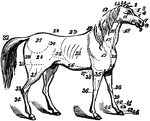
Horse
The anatomy of a horse. 1, ears; 2, forelock; 3, forehead; 4, eyes; 5, eye-pits; 6, nose; 7, nostril;…

Phytocoris
A genus of plant bugs, having the beak extending to the middle of the abdomen and the sides of the head…

Fort Steadman
The Battle of Fort Steadman was one of the Confederacy's last attempts to besiege Petersburg, Virginia.…
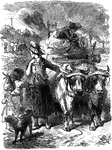
People with Oxen
Women and children with oxen, probably leaving the town in the background. Several figures look back…

Boar's Head Festival Procession
A boar's head is carried into a banquet hall accompanied by musicians. The boar's head festival we know…

